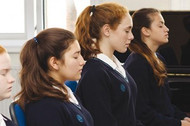Mindfulness in the Classroom - A Meditation Practice
Posted by Jay Suthers on Sep 24th, 2016
 Since the dawn of education, it has been the goal to teach children how the world operates by learning science, literature/writing, and math. Give children an understanding of these principles and one assumes they will become productive members of society. Slowly, we are realizing that we cannot simply teach children
what to think, we must also teach them how to think. Simply knowing the facts doesn't equip them to become functional human beings.
Since the dawn of education, it has been the goal to teach children how the world operates by learning science, literature/writing, and math. Give children an understanding of these principles and one assumes they will become productive members of society. Slowly, we are realizing that we cannot simply teach children
what to think, we must also teach them how to think. Simply knowing the facts doesn't equip them to become functional human beings.
The Mindfulness in Schools Project (MiSP) aims "to encourage, support and research the teaching of secular mindfulness in schools." The goal is to help educators and children to be more mindful about their education so that they not only learn basic traditional skills, but so that they also learn about resilience, well-being, and effectiveness in daily living.
MiSP is an organization in the United Kingdom, but there are organizations in the United States as well such as the Association for Mindfulness in Education, the Mindfulness in Education Network, and Mindful Schools. Though many of these organizations seem to be moving forward, the MiSP movement seems to be advanced by comparison.
What is encouraging is that educators are slowly beginning to understand the value of teaching children mindfulness and mindfulness meditation. These practices help children to identify their feelings so they can more easily express and manage them. The benefits are great and include:
- Increased attention
- Fewer conduct and anger management problems
- Increased emotional regulation
- An ability to self-calm
- Decreased depression and anxiety
This, according to the Association for Mindfulness in Education.
Of course, those of us who practice meditation and mindfulness already know about these benefits. We become less reactive to the world. We tend to remain calm and give ourselves a mindful moment to assess what is going on before we attempt to deal with a situation. When we are not feeling our best, we know how to take a moment to understand what we are feeling, to identify why we are feeling this way, and to realize that whatever triggered our feelings is most likely unimportant or something we need to process before we can continue on with our day.
In today's world, we feel ever-increasing pressure to make quick decisions for fear of losing something. The only thing that has changed in 10,000 years is the way we think and not the way things truly are. Mindfulness and meditation can help us to realize that our thoughts are the key to everything happening around us.
If you feel inspired, please visit the web sites I've presented here and take some time to learn about mindfulness practice in our education system. If you can, participate in some manner. If you are an educator, think of ways you can incorporate these practices in your classroom. Mindfulness is not a religion, so you should be able to introduce it without offending anyone's religious beliefs.
Finally, if you have children, I'm sure you are sharing your mindfulness practice with them. Help them to understand how they can use this practice in school.
I hope this information has been helpful and will help you get involved in growing the movement toward mindfulness.
Thank you for reading,
Jay
If you would like to comment on this blog or have any questions, please feel free to Contact Sage Meditation Customer Service.

